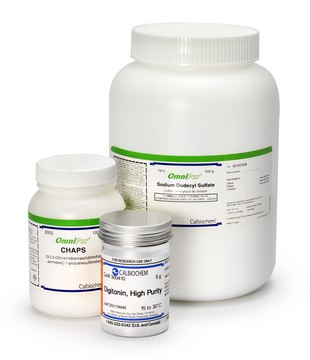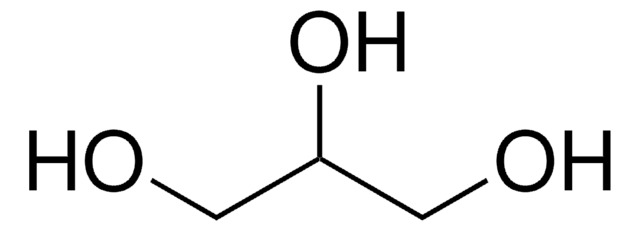P2443
Pluronic® F-127
powder, BioReagent, suitable for cell culture
Synonym(s):
Non-ionic copolymer surfactant
Select a Size
Select a Size
About This Item
Recommended Products
description
Non-ionic
contains 100ppm BHT
product line
BioReagent
form
powder
mol wt
~12600 g/mol
technique(s)
cell culture | mammalian: suitable
CMC
950-1000 ppm (~25°C)
transition temp
cloud point >100 °C
HLB
18 - 23
SMILES string
O2C(C2)C.O1CC1
InChI
1S/C3H6O.C2H4O/c1-3-2-4-3;1-2-3-1/h3H,2H2,1H3;1-2H2
Related Categories
1 of 4
This Item | G9012 | 49767 | G6279 |
|---|---|---|---|
| application(s) life science and biopharma | application(s) lipidomics | application(s) - | application(s) - |
| technique(s) MALDI-MS: suitable, cryopreservation: suitable | technique(s) immunofluorescence: suitable | technique(s) - | technique(s) - |
| grade for molecular biology, reagent | grade - | grade for molecular biology | grade - |
| Quality Level 200 | Quality Level 200 | Quality Level 200 | Quality Level 200 |
| solubility water: 1 mL/mL, clear, colorless | solubility water: 1 mL/mL, clear, colorless to faintly yellow | solubility H2O: 5 M at 20 °C, clear, colorless | solubility - |
General description
Application
- as a delivery system for a peptide to the wound site to study the effect of the peptide on wound healing in mice.[4]
- as a surface coating for PDMS (polydimethylsiloxane) stamps to make them hydrogel repellent.[5]
- in the preparation of calcium indicator stock solution for measuring neural activities.[6]
- as a component of phosphate-buffered saline (PBS), to lower unspecific cell and protein adhesion to a PDMS-based microfluidic device.[7]
- This non-ionic copolymer surfactant is suitable for use in insect cell culture applications as an antifoaming agent.
Biochem/physiol Actions
Legal Information
Storage Class Code
11 - Combustible Solids
WGK
WGK 1
Flash Point(F)
Not applicable
Flash Point(C)
Not applicable
Personal Protective Equipment
Choose from one of the most recent versions:
Certificates of Analysis (COA)
Don't see the Right Version?
If you require a particular version, you can look up a specific certificate by the Lot or Batch number.
Already Own This Product?
Find documentation for the products that you have recently purchased in the Document Library.
Which document(s) contains shelf-life or expiration date information for a given product?
If available for a given product, the recommended re-test date or the expiration date can be found on the Certificate of Analysis.
How do I get lot-specific information or a Certificate of Analysis?
The lot specific COA document can be found by entering the lot number above under the "Documents" section.
What is the molecular weight of Pluronic F-127, Product P2443?
The average molecular weight is 12.6 kDa.
Why has my solution of Pluronic F-127, Product P2443, gelled?
Pluronic F-127 will form gels above 10 °C when used at concentrations of 18-50%. It will re-liquefy when cooled to below 10 °C. The gel should remain stable during autoclaving.
What concentration of Pluronic F-127, Product P2443, should be used in cell culture?
We test Pluronic F-127 in cell culture at 0.1 g/100 ml media (0.1%). The concentration necessary for your cell application may vary.
What can I use to dilute Pluronic F-127, Product P2443?
The Pluronic F-127 is water soluble as stated on the Specification Sheet.
How do I find price and availability?
There are several ways to find pricing and availability for our products. Once you log onto our website, you will find the price and availability displayed on the product detail page. You can contact any of our Customer Sales and Service offices to receive a quote. USA customers: 1-800-325-3010 or view local office numbers.
What is the Department of Transportation shipping information for this product?
Transportation information can be found in Section 14 of the product's (M)SDS.To access the shipping information for this material, use the link on the product detail page for the product.
My question is not addressed here, how can I contact Technical Service for assistance?
Ask a Scientist here.
Articles
Local delivery of bioactive molecules using an implantable device can decrease the amount of drug dose required as well as non-target site toxicities compared to oral or systemic drug administration.
Related Content
Tissue engineering fabricates tissues cultures from scaffolds, living cells, and biologically active molecules by simulating the microenvironment of the body to repair or replace damaged tissue.
Our team of scientists has experience in all areas of research including Life Science, Material Science, Chemical Synthesis, Chromatography, Analytical and many others.
Contact Technical Service



